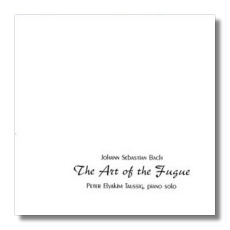
The Internet's Premier Classical Music Source
Related Links
- J.S. Bach Reviews
- Latest Reviews
- More Reviews
-
By Composer
-
Collections
DVD & Blu-ray
Books
Concert Reviews
Articles/Interviews
Software
Audio
Search Amazon
Recommended Links
Site News
 CD Review
CD Review
This is one of those rare recordings whose methods must be discussed in detail before its results. Pianist Peter Elyakim Taussig is a Canadian pianist afflicted by carpal tunnel syndrome and osteoarthritis. He has in fact lost the ability to perform in concert with his right hand. This recording is the product of high technology: Taussig used a Yahama Disklavier PRO, which allows redubbing and computer enhancements. Thus, the pianist recorded both keyboard parts with his left hand and afterwards adjusted tempos, dynamics and other performance properties, shaping the whole much the way a conductor might fashion his interpretation. It would be foolish here then to talk about technique or other physical characteristics of keyboard performance – but if I could I would judge them all as quite impressive.
Some people will object to Taussig's method altogether, asserting it strips the music of any sense of momentary creativity, reducing the performance to a sterile, calculated process. But, of course, this same argument has been used against studio recordings in general, whose multiple takes and edits produce a performance comprised of body parts that are often more a conglomerate than the biggest multinational corporations. Moreover, computer-processed music – a perfectly legitimate mode of artistic expression, you'll concede – was born of technology and tweaking, of stretched sounds and sonic sleight-of-hand. If you listen to studio recordings then, it is only fair to judge this CD's end, not its means.
And its end is quite good. Taussig's interpretation is solid and insightful. I'm not sure he'll quite stand with Gould or Tureck or other names we associate with great Bach keyboard playing, but his performance is fully convincing, with inner voices emerging with both intelligence and feeling. He also avoids extreme tendencies: indeed, where Gould fanatically suppressed any sense of legato playing, Taussig produces a more middle-of-the-road approach in balancing staccato and legato. In sum, his readings are tasteful and deftly-conceived.
What he plays here are the eleven complete Contrapuncti, followed by the four Cannons, three "mirror fugues", and the Contrapunctus #14, the piece Bach was working on when he died. It breaks off abruptly at bar 239 in the score, which is where Taussig wisely leaves it. The only drawback to this CD is the slightly artificial sound of the piano. While it does not have phony or unpleasant sonic properties, it develops some congestion in the upper ranges and in louder passages. Still, this flaw is not serious and should not detract from the listener's overall enjoyment. In the end then, this is a fine, if bare-bones production: notes are skimpy and packaging frills are practically nonexistent, but should this matter in so unique a project? Now if only Taussig could give us a concerto or two – working the orchestral half into the sonic fabric via high-tech workings – that might also intrigue the ear.
Copyright © 2002, Robert Cummings



















